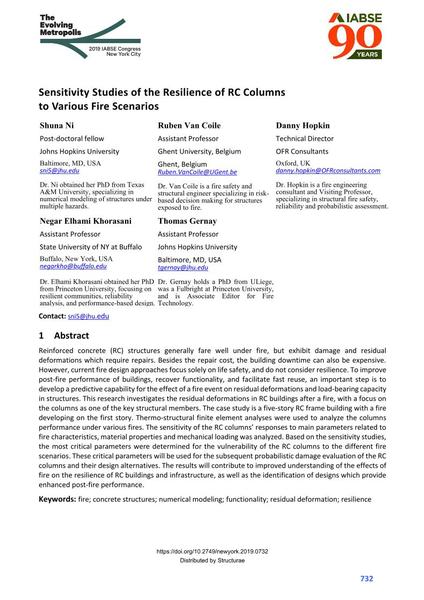Sensitivity Studies of the Resilience of RC Columns to Various Fire Scenarios

|
|
|||||||||||
Bibliographic Details
| Author(s): |
Shuna Ni
(Johns Hopkins University)
Ruben Van Coile Danny Hopkin (OFR Consultants) Negar Elhami Khorasani Thomas Gernay (Johns Hopkins University) |
||||
|---|---|---|---|---|---|
| Medium: | conference paper | ||||
| Language(s): | English | ||||
| Conference: | IABSE Congress: The Evolving Metropolis, New York, NY, USA, 4-6 September 2019 | ||||
| Published in: | The Evolving Metropolis | ||||
|
|||||
| Page(s): | 732-736 | ||||
| Total no. of pages: | 5 | ||||
| DOI: | 10.2749/newyork.2019.0732 | ||||
| Abstract: |
Reinforced concrete (RC) structures generally fare well under fire, but exhibit damage and residual deformations which require repairs. Besides the repair cost, the building downtime can also be expensive. However, current fire design approaches focus solely on life safety, and do not consider resilience. To improve post-fire performance of buildings, recover functionality, and facilitate fast reuse, an important step is to develop a predictive capability for the effect of a fire event on residual deformations and load-bearing capacity in structures. This research investigates the residual deformations in RC buildings after a fire, with a focus on the columns as one of the key structural members. The case study is a five-story RC frame building with a fire developing on the first story. Thermo-structural finite element analyses were used to analyze the columns performance under various fires. The sensitivity of the RC columns’ responses to main parameters related to fire characteristics, material properties and mechanical loading was analyzed. Based on the sensitivity studies, the most critical parameters were determined for the vulnerability of the RC columns to the different fire scenarios. These critical parameters will be used for the subsequent probabilistic damage evaluation of the RC columns and their design alternatives. The results will contribute to improved understanding of the effects of fire on the resilience of RC buildings and infrastructure, as well as the identification of designs which provide enhanced post-fire performance. |
||||
| Keywords: |
concrete structures fire resilience numerical modeling functionality residual deformation
|
||||
